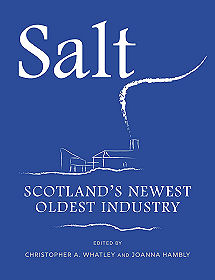 |
"Salt: Scotland’s Newest Oldest Industry", edited by Christopher Whatley & Joanna Hambly, is one of those all-too-rare books that cover their subject so definitively that it's hard to imagine anyone ever wanting or needing to write another book on the subject. Certainly, if anyone does want to discuss the history and current practice of salt-making in Scotland at any time in the future, they will need to reference this book in doing so. If you've ever stumbled over historical references to salt making in Scotland and wanted to know more - or wondered about coastal settlements whose names include "salt" or "pans" - then this is the book for you.
"Salt" comprises fourteen chapters written by a wide range of contributors. The understated (but very clever once you work it out) cover leaves you unsure what to expect within, but the contents are varied, interesting and accessible.
The book opens with an excellent introduction by the editors and we then move on to a brief history of Scottish salt; a chapter looking at working lives at the pans; and one looking at the archeology of Scottish salt. The second, larger, part of the book uses contributions from researchers in a wide variety of fields to tell the stories of the people and places of historical salt manufacture. Different approaches to modern Scottish salt-making are also discussed in detail. You also get a very good sense of the contents from the publisher's description:
"Salt is a vital commodity. For many centuries it sustained life for Scots as seasoning for a diet dominated by grains (mainly oats), and for preservation of fish and cheese.
"Sea-salt manufacturing is one of Scotland’s oldest industries, dating to the eleventh century if not earlier. Smoke and steam-emitting panhouses were once a common sight along the country’s coastline and are reflected in many of Scotland’s placenames. The industry was a high-status activity, with the monarch initially owning salt pans. Salt manufacture was later organised by Scotland’s abbeys and then by landowners who had access to the sea and a nearby supply of coal. As salt was an important source of tax revenue for the government, it was often a cause of conflict (and military action) between Scotland and England. The future of the industry – and the price of salt for consumers – was a major issue during negotiations around the Union of 1707.
"This book celebrates both the history and the rebirth of the salt industry in Scotland. Although salt manufacturing declined in the nineteenth century and was wound up in the 1950s, in the second decade of the twenty-first century the trade was revived. Scotland’s salt is now a high-prestige, green product that is winning awards and attracting interest across the UK."
InformationPaperback: 240 pagesJohn Donald/Birlinn Ltd birlinn.co.uk 14 September 2023 Language: English ISBN-10: 1910900974 ISBN-13: 978-1910900970 Size: 15.6 x 2.2 x 23.4 cm Buy from Amazon (paid link) Visit Bookshop Main Page |
